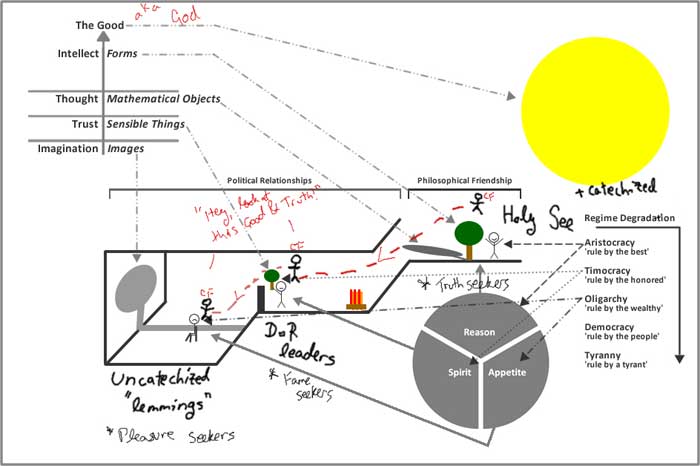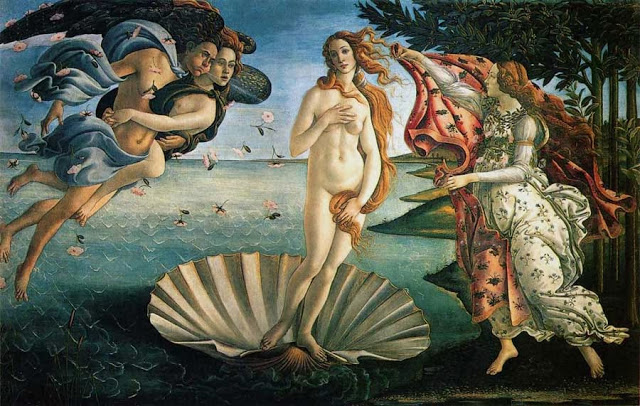
Justice as Apparatus
You are recruited, solicited to be a consultant, to testify and give testimony with respect to Justice, whatever your personal experience of it will have been. We (heuretic subjects, EmerAgency egents) undertake the invention of electracy as an update of Justice for our epoch and apparatus. Electracy is not invented "in general." The prototype for our project is provided by Plato, founder of the first school (the Academy in Athens), one of the inventors of literacy. He is credited by the grammatologist Eric Havelock with inventing the first concept (the fundamental cognitive device of literacy), specifically, the concept of Justice. Plato did not invent "Justice" as experience, event, virtue, history, but rather the literate means of addressing, understanding, and acting in a just way, for individuals and states. There was already in place an oral modality of Justice. We find it recorded in Homer's epics, for example, as in the story of the anger of Achilles, his withdrawal from the battle at Troy in response to the injustice suffered at the hands of his commander, Agamemnon, over the distribution of booty. twohundredfifty years before Plato, Hesiod collected an archive of examples of actions just and unjust, displaying a pattern for Plato. Plato asked the question that founds Philosophy: what is justice, itself? The universal principle, the definition of the written term, identifying the properties necessary to the function or purpose of Justice as such. The terms of this defintion provide a measure with which to assess the claims of any particular condition to be just or not.
What is our prototype? An inventory of Plato's relay produces the following set of integrated creations:
- Technology: the availability of alphabetic writing, accumulating over several centuries a documentation of the cultural archive (epics of Homer for example), the recent transitional form of tragedy, recording for storage and retrieval the spoken Greek language.
- Institution: the Academy, the first "school" in the Western tradition, devoted to the design and testing of the practices of writing, opening a place for exercising the faculty and capacity of pure disinterested reason.
- Form: Dialogue, a discourse genre for creating, testing, and disseminating literate learning, using dramatizations of conversations as an interface metaphor to introduce newly literate (oral) learners to dialectical thinking.
- Persona: Socrates, Plato's mentor and predecessor, whose history was appropriated by Plato to function as an "image of thought," to perform and model the life of a lover of wisdom, applying critical reason to questions of how to live the best life.
 The heuretic method is to accept this inventory as a template, and to propose equivalents for electracy, which is what we will do as the lessons unfold. Meanwhile, there is a further specificaion. The dialogue in question is The Republic, in which the new concept of Justice is situated within a general account of the kind of education in literacy, the one capable of producing a truly Just society. At the heart of this dialogue is one of the most famous, most familiar, fables in the Western tradition -- the allegory of the cave. The full text is readily available online. Our method demands that we propose an equivalent, an allegory that expresses the core of our educational model, a figure of electrate metaphysics. It is worth remembering that the cave holding the prisoners alludes to the rituals of the Orphic cults, the Eleusinian Mysteries, constituting the religion dominant in tribal, oral, Ancient Greece. The prisoner is released from chains, turned around (conversion), led out of the cave into the light of day, to experience full sunlight for the first time. This Sun represents the Good: the eye is to the sun what the soul is to the Good (there is an eye in the soul). This ratio itself is part of our relay: A : B :: C : D. The fundamental experience (what the learner undergoes) is conversion (this turning about).
The heuretic method is to accept this inventory as a template, and to propose equivalents for electracy, which is what we will do as the lessons unfold. Meanwhile, there is a further specificaion. The dialogue in question is The Republic, in which the new concept of Justice is situated within a general account of the kind of education in literacy, the one capable of producing a truly Just society. At the heart of this dialogue is one of the most famous, most familiar, fables in the Western tradition -- the allegory of the cave. The full text is readily available online. Our method demands that we propose an equivalent, an allegory that expresses the core of our educational model, a figure of electrate metaphysics. It is worth remembering that the cave holding the prisoners alludes to the rituals of the Orphic cults, the Eleusinian Mysteries, constituting the religion dominant in tribal, oral, Ancient Greece. The prisoner is released from chains, turned around (conversion), led out of the cave into the light of day, to experience full sunlight for the first time. This Sun represents the Good: the eye is to the sun what the soul is to the Good (there is an eye in the soul). This ratio itself is part of our relay: A : B :: C : D. The fundamental experience (what the learner undergoes) is conversion (this turning about).
Share this
Comments

Ascent

The generation of an electrate allegory is framed with a series of prompts or advisories, suggesting analogies for the cave allegory of literacy in Plato's Republic, with a similar context for the wave allegory in electracy. The prompts may be summarized in a representative work, as an emblem of the larger issue.
The first prompt concerns theme: The Republic is about the new kind of education required to support a literate civilization. Another version of the allegory is found in the Symposium, in Socrates's account of his conversation with Diotima on the nature of love.
His point is that the ascent to contemplation of the Good (Absolute Form) begins in physical desire: Eros as sexual attraction. Renaissance Neoplatonism, the Humanism of the Florentine Academy, represents the full syncreism of Greco-Roman, Judeo-Christian civilization in the midst of a turn to modernity. One of most famous versions of this allegory of Reason is The Birth of Venus, Sandro Botticelli, commissioned by the Medici family.
